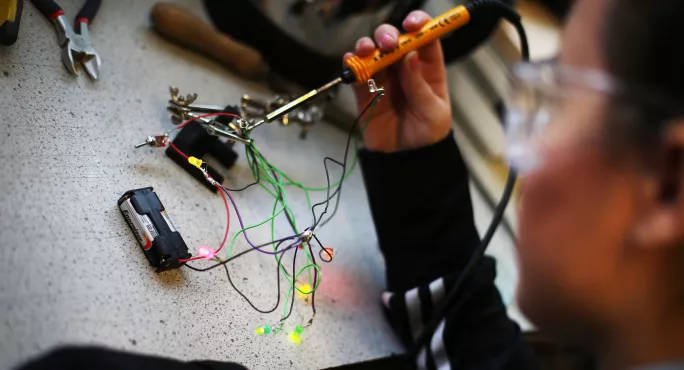- Home
- 4 ways to spark your GCSE electricity lessons into life
4 ways to spark your GCSE electricity lessons into life

If you talk to a group of science teachers about what the most difficult topic to teach is, the answer will almost definitely be electricity.
But the unavoidable reality is that it forms a substantial chunk of the GCSE specification.
And this can pose a real problem when planning to teach it effectively.
Quick read: Four ways to avoid shocking electricity lessons
Quick listen: Why peer learning is more effective than you think
Want to know more? 4 steps to make maths feel more relevant to pupils
Electricity is a really abstract concept, but one that everyone has lots of experience with.
It is the golden thread running through our everyday life, essential to our tech-thirsty teenagers, but it is just not tangible.
So how can we approach it usefully?
Science GCSE: lessons on electricity
Establish prior knowledge
In primary school, students learn how to construct simple circuits, use appropriate symbols to construct diagrams and relate the brightness of a bulb’s voltage. They may also understand the concept of metallic bonding and conductivity.
But, for a secondary teacher, none of these are a given, especially if you have a few feeder primary schools. Therefore, establishing what pupils already know is key.
Multiple-choice tests have developed a bad reputation in the past. Less of a test and more of a best-guess scenario; where the correct answer was often so obvious, the incorrect choices almost served as humorous anecdotes.
However, thanks to the work of cognitive scientists such as Robert A Bjork, professor of psychology at the University of California, we are now able to see the benefits of multiple-choice tests. In a research paper in 2012, he and his fellow researchers debunked some of the myths:
“We tested whether multiple-choice tests could trigger productive retrieval processes, provided the alternatives were made plausible enough to enable test-takers to retrieve both why the correct alternatives were correct and why the incorrect alternatives were incorrect.”
Thus, getting to grips with your classes’ starting point with a quick, cleverly designed multiple-choice pre-test can establish prior knowledge and introduce the topic and expected outcomes to lay foundations and engage students.
Identify misconceptions
Along with lots of prior knowledge can come lots of misconceptions. My particular favourite is when students think wires are empty and turning on a power source fills them up with electricity. Identifying and correcting these is a fundamental first step.
Using the pre-test, if designed with common misconceptions in mind, can provide lots of opportunity to do this. Along with the correct answer, use common misconceptions and deliberate distractors to really draw out current thinking on electricity and establish a starting point for teaching.
Use lots of models
Electricity is an abstract concept. Students cannot see it. Therefore, how do they visualise it?
Utilising lots and lots of well-constructed, visual models to demonstrate metallic bonding, current, charge and resistance, with tried-and-tested methods such as dual coding, can help with visualisation, avoid future misconceptions and really support memory, retrieval and schema formation.
Deliberate practice
Achieving expertise (or at least moving away from novice status) in their understanding of electricity and its associated concepts can be supported by deliberate practice. K Anders Ericsson, professor of psychology at Florida State University, explores deliberate practice in a range of domain-specific settings and identifies it as a key indicator in expertise and performance.
Problems around circuits that will and won’t work, utilising formula and rearranging equations and rehearsing definitions are key to deepening understanding and securing memory of the key knowledge in this topic.
Teaching and learning electricity is hard. However, with carefully prepared quizzes, models and plenty of practice, this can be the bright spark of your physics curriculum.
Louise Lewis is a research lead and deputy head of science in a Yorkshire secondary school. She tweets @MissLLewis
Keep reading for just £1 per month
You've reached your limit of free articles this month. Subscribe for £1 per month for three months and get:
- Unlimited access to all Tes magazine content
- Exclusive subscriber-only stories
- Award-winning email newsletters



